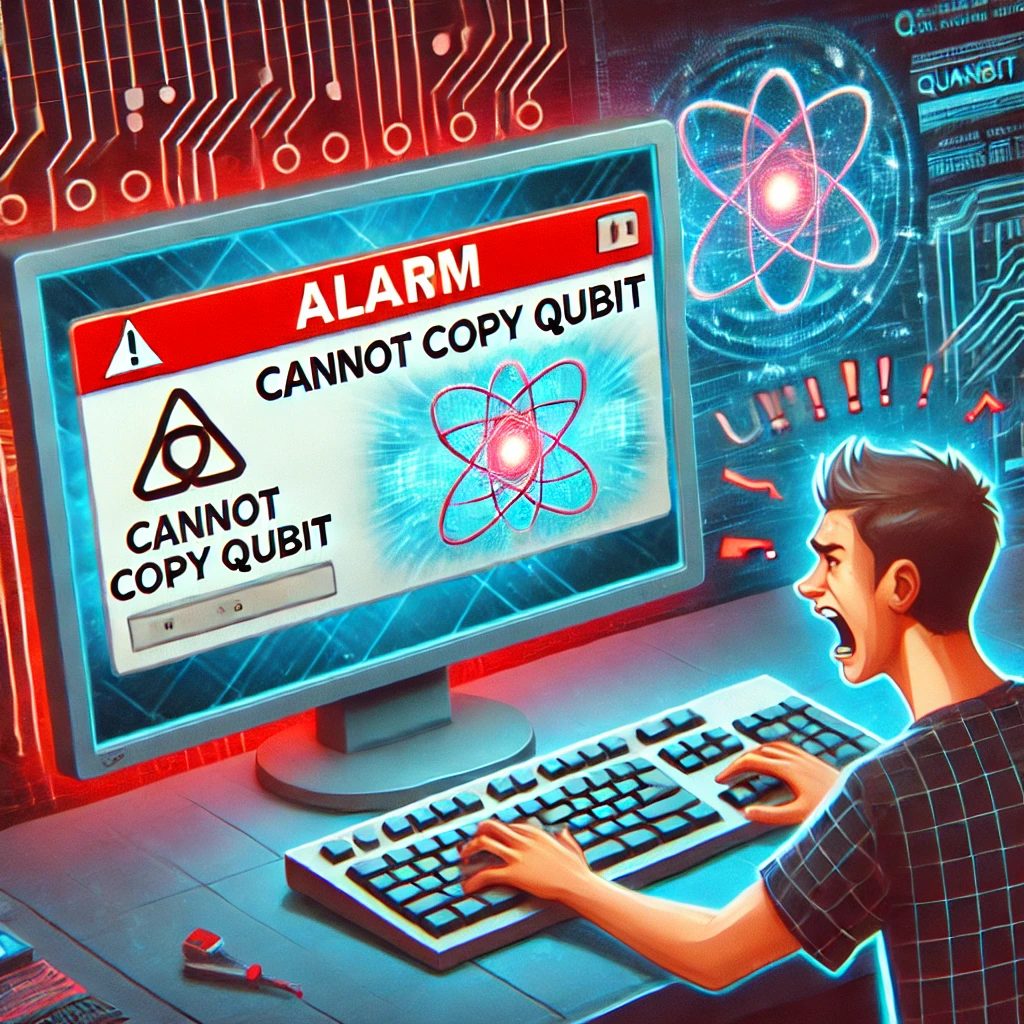Unable to Copy Qubits: the No-Cloning Theorem

Introduction
So far, we’ve talked about logical qubits (idealized, error-free qubits used in quantum algorithms) and physical qubits (the noisy, hardware-implemented qubits in real quantum computers). One of the biggest challenges in quantum computing is error correction: how do we implement logical qubits from protecting noise and errors in physical qubits?
In classical computing, the solution is simple: copy the data. If a memory chip is prone to bit flips, we can store redundant copies and use majority voting to detect and correct errors. For example, in a triple-redundancy scheme:
000,001,010,100: interpreted as0111,110,101,011: interpreted as1
Even if one bit flips due to noise, the system still retrieves the correct value.
However, quantum computing faces much trickier problem—we can’t simply copy qubits like the way we copy classical bits. This is due to a fundamental principle of quantum mechanics: the no-cloning theorem.
Why Can’t We Just Copy Qubits?
In classical computing, duplicating data is second nature. In quantum computing, it’s fundamentally impossible due to the no-cloning theorem, which states that we can’t create an exact copy of an arbitrary quantum state. This restriction has deep consequences for quantum information and error correction.
The Intuition Behind No-Cloning
A quantum state is like a mystery box—you can’t fully “look inside” (measure it) without disturbing it. If you try to measure a qubit’s state to make a copy, you collapse its quantum superposition, losing the original information. Since perfect copying would require knowing the quantum state without disturbing it, it’s impossible.
Mathematical Proof
If copying were possible, there would exist a unitary operator $U$ that copies an arbitrary quantum state $\ket{\psi}$:
\[U(\ket{\psi} \otimes \ket{0}) = \ket{\psi} \otimes \ket{\psi},\]where $\ket{0}$ is an auxiliary qubit starts in a known state $\ket{0}$
Let’s analyze an inner product of two arbitrary states $\ket{\phi}$ and $\ket{\psi}$:
\[\prths{\bra{\phi} \otimes \bra{0}} \cdot \prths{\ket{\psi} \otimes \ket{0}} = \braket{\phi}{\psi} \braket{0}{0} = \braket{\phi}{\psi} \cdot 1 = \braket{\phi}{\psi}.\]Now, remind the definition of the unitary operator: a unitary operator $U$ must satisfy $U^{\dagger}U = I$, where $U^{\dagger}$ is the adjoint of $U$ (please refer to the Introduction to Quantum Mechanics with Cats article if you need a refresher).
Inserting the identity operator $I$ between the two states, we can rewrite the inner product as:
The calculation is quite straightforward. However, we can insert the identity operator $I$ and use the property $U^{\dagger}U = I$, we compute:
\[\prths{\bra{\phi} \otimes \bra{0}} \cdot U^\dagger U \cdot \prths{\ket{\psi} \otimes \ket{0}},\]which simplifies to:
\[\prths{U \prths{\ket{\phi} \otimes \ket{0}}}^\dagger \cdot \prths{U \prths{\ket{\psi} \otimes \ket{0}}}.\]Expanding the effect of $U$ (Note that $\prths{\ket{\phi} \otimes \ket{\phi}}^\dagger = \bra{\phi} \otimes \bra{\phi}$):
\[\prths{\bra{\phi} \otimes \bra{\phi}} \cdot \prths{\ket{\psi} \otimes \ket{\psi}} = \braket{\phi}{\psi} \braket{\phi}{\psi} = \braket{\phi}{\psi}^2.\]This is a contradiction, as the inner product of two states is equal to the square of the inner product of the same states:
\[\braket{\phi}{\psi} = \braket{\phi}{\psi}^2 \Rightarrow \braket{\phi}{\psi} = 0 \text{ or } 1.\]This equation only holds for $\braket{\phi}{\psi} = 0$ (orthogonal states) or $\braket{\phi}{\psi} = 1$ (identical states). That means only classical-like states can be copied, but general quantum state cannot.
Thus, a general quantum cloning operation is impossible.
Side Note
Although the no-cloning theorem prevents us from copying qubits, it has some interesting consequences:
- Quantum Key Distribution (QKD): The BB84 protocol uses the no-cloning theorem to ensure that eavesdroppers can’t intercept quantum-encrypted messages without detection.
- Quantum Teleportation: While we can’t copy a quantum state, we can transfer a state from one quit to another using quantum teleportation—which is closer to a “cut-and-paste” than “copy-and-paste”.
Is This the End?
If we can’t copy qubits, does that mean quantum error correction is impossible? Not at all. Instead of copying qubits, we can spread quantum information across multiple qubits, allowing us to detect and correct errors without directly measuring the quantum state.
In the next article, we’ll explore how quantum error correction works, starting with the simplest example: the three-qubit bit-flip code.
All images in this article were generated by ChatGPT.

Leave a comment